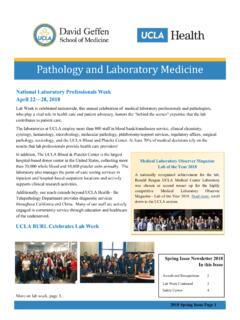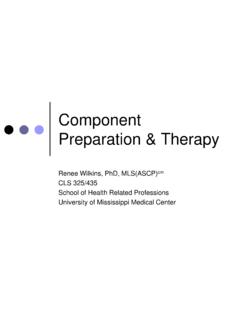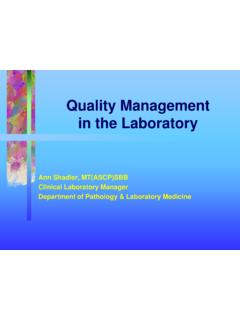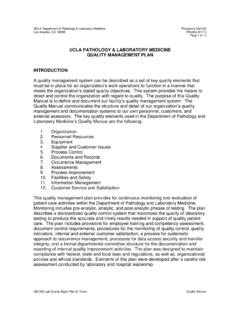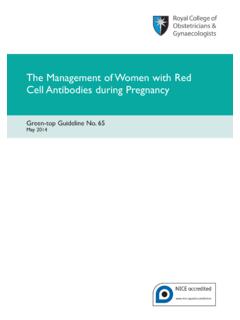Transcription of Apheresis: Basic Principles, Practical Considerations and ...
1 Apheresis: Basic Principles, Practical Considerations and Clinical ApplicationsJoseph Schwartz, MD Director, Transfusion Medicine Columbia Univ. Medical CenterNew York Presbyterian Hospital Anand Padmanabhan, MD PhDAssoc Med Director/Asst ProfBloodCenter of WisconsinMedical College of WisconsinReview Session, ASFA Annual meeting, Scottsdale, Arizona, June 2011 Objectives (Part 1) Mechanism of Action Definitions Technology (ies) Use Practical Considerations Math Clinical applications HPC Collection Clinical applications: System/Disease Specific Indications ASFA Fact SheetObjectives (Part 2) Apheresis Derives from Greek, to carry away A technique in which whole blood is taken and separated extracorporealy, separating the portion desired from the remaining blood . This allows the desired portion ( , plasma) to be removed and the reminder of Action Large-bore intravenous catheter connected to a spinning centrifuge bowl Whole blood is drawn from donor/patient into the centrifuge bowl The more dense elements, namely the RBC, settle to the bottom with less dense elements such as WBC and platelets overlying the RBC layer and finally, plasma at the very top.
2 Torloni MDTorloni MDTorloni MDPlateletsLymphocytesMonocytesGranulocy teRBC(1040)(1050-1061)(1065 -1069)(1087 -1092)Apheresis: Principles of SeparationSeparate blood components is based on density with removal of the desired componentGraphics owned by and courtesy of Gambro BCTWBCRBCP lasmaGCobe SpectraTorloni MDTorloni MDPlasmaRBCWBCP rincipals of ApheresisApheresis-Mechanism of ActionDefinitions Plasmapheresis: plasma is separated, removed ( less than 15% of total plasma volume) without the use of replacement solution Plasma exchange (TPE):plasma is separated, removed and replaced with a replacement solution such as colloid ( albumin and/or plasma) or combination of crystalloid/colloidSzczepiorkowski et at, Clinical Applications of Therapeutic Apheresis, J Clin Apheresis 2007, 22, : Fluid DynamicsEXTRACELLULARINTRACELLULARINTERS TITIALINTRAVASCULAR42 L28 L14 L10 L4 LKNaLymphaticsINTRAVASCULARP lasma Exchange: Mathematical ModelsIntracellularInterstitialModified from: Weinstein, Apheresis: Principles and Practice-AABB pressCatabolismTechnology Automated centrifugal cell separators allow large of blood to be processed in a short period of time Discontinuous flow: Haemonetics MSC plus, V50, V30 Continuous flow: Cobe spectra, CS 3000, Fresnius AS 104, Spectra optia Use of Apheresis Donor -facilitate collection of a blood component from an allogeneic donor: Platelets, Granulocytes, source plasma, HPC collection Therapy(therapeutic apheresis):*removing undesired substances like antibodies, lipids*reducing excess WBC/Platelets *automated exchange of sickled RBC *HPC collection Use of Apheresis (cont.)
3 Therapeutic apheresis assures the immediate removal of abnormal substances from the circulation, which are either:*present in plasma*or tightly bound to plasma proteinsAbnormal Substances Removed From the Circulation by TPE1)Paraproteins (Waldenstorm s Macroglobulinemia)2)Autoantibodies (Myasthenia Gravis, Goodpasture s syn.)3)Lipids (LDL in familial hypercholesterolemia; phynatic acid in refsum s disease4)Toxins or drugs (that are bound to albumin)5)Circulating immune complexes (CIC)6)Soluble mediators of inflammatory response (activated complement component, vasoactive substances)Apheresis Procedural Elements (+ Practical Considerations ): Venous access Replacement fluid Normal/abnormal constituents removed Anticoagulation Patient history and medications Frequency and number of procedures Complications Apheresis Procedural Elements (+ Practical Considerations ): Venous access Replacement fluid Normal/abnormal constituents removed Anticoagulation Patient history and medications Frequency and number of procedures Complications Venous Access*Apheresis require large bore venous catheters to sustain the flow rates required (50-100 ml/min)Type of catheters: 17 gauge therumo butterflies-double lumen dialysis catheters fr (Shiley, Quinton, Vascath, Permacath)-Avoid standard Hickman or triple-lumen designs.
4 Flow rates are inadequate *Location:Peripheral: antecubital fossacentral: femoral/subclavian/jugulararteriovenous shunt/fistula *Number of lines: intermittent flow devices (draw and return via the same line): single line-continuous flow devices : separate linesVenous Access (cont.) Planned/occasional procedure -peripheral line and removal after the procedure Few days/ bed rest-femoral line (risk of infection/thrombosis) Multiple procedures for a long period of time -neck central vein or artriovenous shunt/fistula Do not forget:*Dressing change*FlushApheresis Procedural Elements (+ Practical Considerations ): Venous access Replacement fluid Normal/abnormal Constituents Removed Anticoagulation Patient History and Medications Extracorporeal Volume Frequency and number of proceduresReplacement FluidMust be FDA approved to use w/ blood products [ get mixed w/rbc before the return phase]Replacement solutions:*Crystalloids normal saline *Colloids 5% albumin.
5 PlasmaReplacement Fluid*The primary function of the replacement fluid is to maintain intravascular volume**additional features:-Restoration of important plasma proteins-Maintenance of colloid osmotic pressure-Maintenance of electrolyte balance Replacement FluidsTTP/HUSFFPC ryodepleted FFPM ixtures : Albumin /FFPA lbumin /FFPN eurologicalGBS, MG, Stiff-manCIDP5% Human AlbuminAlbumin/Saline (70% /30%)Renal(RPGN, FSGS)5% Human AlbuminAlbumin/Saline (70% /30%)Post Transplant5% Human AlbuminAlbumin/Saline (70% /30%)Consider adding FFP at the end if post opPatients with hepatic failure, coagulopathy, pre-op or post-op use FFP or finish with FFPR eplacement FluidAdvantageDisadvantageCrystalloidLow costHypoallergenicNo infectious riskHypo-oncoticNo coagulation factorsNo immunoglobulins2-3 volumes requiredAlbuminIso-oncoticNo infectious riskHigher costNo coagulation factorsNo immunoglobulinsPlasmaImmunoglobulinsCoag ulation factorsIso-oncoticInfectious riskCitrateAllergic reactionsABO compatibilityComparison of Replacement FluidsReplacement Fluid and Balance3 choices of fluid balance (FB).
6 1)100% FB isovolemic volume replaced=volume removed2)<100% FB hypovolemic ( dry ) -volume replaced < volume removed3)>100% FB hypervolemic ( wet ) -volume replaced > volume removedApheresis Procedural Elements (+ Practical Considerations ): Venous access Replacement fluid Normal/abnormal constituents removed Anticoagulation Patient history and medications Frequency and number of procedures Complications Normal/abnormal Constituents RemovedTPE: One volume exchange removes about 63%-65% of most plasma constituents A single two-volume exchange removes about 86% of plasma constituentsIncreasing the volume beyond volumes has very little impact on removal of plasma constituentsVolume of Patient Plasma Exchanged (PEX)1pv= 63%, 2 vol=86% , 3 vol=95%Volume of Patient Plasma Exchanged (PEX) Little advantage beyond volumes 1pv= 63%, 2 pv=86% , 3 pv=95% Removal of IgG and IgM by plasma exchange:measureIgGIgMintravascular amount45%76% total body PEX PEX PEX Normal/abnormal Constituents RemovedTPE: One volume exchange removes about 63%-65% of most plasma constituents A single two-volume exchange removes about 86% of plasma constituentsIncreasing the volume beyond volumes has very little impact on removal of plasma constituentsNormal Constituents RemovedCoagulation factors: Most coagulation factors are lost at the same rate Rapidly synthesized;replacement usually is 2-3 days following exchange Practical : measure PT/PTT/Fibrinogen every 2-3 days (rather then daily)Platelets: 25-30% per procedure Endogenous synthesis replaces lost platelets within 2-4 days (except hypoplastic/aplastic marrow) Lab work(esp.
7 Chemistry): not immediate post-procedure; allow equilibrium intra/ extravascular spaceApheresis Procedural Elements (+ Practical Considerations ): Venous access Replacement fluid Normal/abnormal constituents removed Anticoagulation Patient history and medications Frequency and number of procedures Complications AnticoagulationAnticoagulation citrate Dextrose (ACD): Found in human cells, plant cells, and citrus fruits Chelates positively charged calcium ions (ionized calcium) and blocks calcium-dependent clotting factor reactions Works extracorporeally Metabolized in the liver almost immediately upon return Side effects: hypocalcemia. small pts, large vol. of citrated blood , liver dysfunctionHeparin: Prevents conversion of fibrinogen to fibrin and prothrombin to thrombin Systemic anticoagulation Metabolized slowly 1-2 hours Individual sensitivity and elimination ratesAnticoagulationApheresis Procedural Elements (+ Practical Considerations ): Venous Access Replacement Fluid Normal/abnormal Constituents Removed Anticoagulation Patient History and Medications Frequency and Number of Procedures Complications Patient History and Medications Does patient have a disease which is amenable to treatment by the requested apheresis procedure Does the patient/donor capable of sustaining the fluid shifts associated with apheresis Certain medications, most notably antibiotics and anticoagulant can be removed by apheresis -should be given immediately afterthe procedure Angiotensin-converting enzymes (ACE) inhibitorsACE inhibitorsAngiotensin IAngiotensin InhibitorXNo vasoconstrictive effectXIIXII I & IIXACE Inhibitor1-Activation of XII 2-Inhibition of Kinase IIACE inhibitors and ApheresisApheresis Procedural Elements (+ Practical Considerations ).
8 Venous access Replacement fluid Normal/abnormal constituents removed Anticoagulation Patient history and medications Frequency and number of procedures Complications Frequency and Number of ProceduresSubstanceVolume Treated Treatment IntervalNumber of TreatmentsAutoantibodies40 6024 484 6 Immune complexes40 6024 48treat to responseParaproteins40 6024treat to responseCryoproteins40 6024 48treat to responseToxins40 6024 72treat to responseTTP / HUS40 24to remission(ml/kg) (hours)Modified from : Weinstein, in McLeod, Apheresis, Principles and Practice, 3rdedition, AABB press, 2010 Depends on: Disease being treated, Patient signs and symptoms, Lab valuesAlteration in blood Constituents by a 1-PV ExchangeClotting factors25 5080 100 Fibrinogen6365 Immuneglobulins6345 Paraproteins20 30 VariableLiver Enzymes55 60100 Bilirubin45100C36360 100 Platelets25 3075 100 Constituent% decrease% recovery 48 hrs post exchangeModified from : Weinstein, in McLeod, Apheresis, Principles and Practice, 3rd edition, AABB press, 2010 Interval between Exchanges : Why we do what we Procedural Elements (+ Practical Considerations ): Venous access Replacement fluid Normal/abnormal constituents removed Anticoagulation Patient history and medications Frequency and number of procedures Complications Complications1) HypotensionS/S: lightheadednesspulse ratedizzinessshallow breaths faintnessperspirationTreatment: head of bed, foot of bed, Give NS, Monitor VS,Look for drugs (ACE inhibitors)2) Vasovagal syncopeS/S.
9 B/Ppulse ratefeeling of apprehension, distress, doomnausea, Pallor, sweating, syncope, convulsionsTreatment:same as hypotentionComplications -2 3) HypocalcemiaS/S: Parasthesia, perioral tinglingChills/vibrations of chest wallSevere citrate toxicity -tetany, heart rhythm disturbancesTreatment: AC flow rate to the patientDecrease blood flow rateGive Ca tables (Tums)Give dairy productsFor severe citrate toxicity stop procedure, IV CalciumComplications -34) Allergic reaction:Etiology: blood products/ ethylene oxide/ACE inhibitorsS/S: hivesswelling (eyes,lips, tongue)rashbreathing difficultiesflushing, hypotension (m/p ACE inhibitors)burning eyes, periorbital edema (m/p ethylene oxide)Treatment:Pause procedureGive medication per order: Antihistamines, corticosteroids, epinephrineDiscontinue procedure if no improvement Complications 4 5) Other side effects:*Vascular access: hematoma, phlebitis, infection*Air embolism*Loss of blood components: bleeding *Thrombocytopenia (30% decrease)*Hypofibrinogenemia (50% decrease)Journal of Clinical Apheresis16:3, 130 Therapeutic Apheresis MathBlood/Plasma Volume Total blood Volume (TBV):-Height-Weight-Sex Plasma Volume-TBV x (1-Hct) blood /Plasma Volume Calculations Calculate treatment dose TPE and RBC Exchange replacement fluid volumes Cytoreduction and PBSC collections Determine patient tolerance/safetyCalculating % of extracorpreal volume-The amount of blood outside the patient s body at any given time-Should not exceed 15% of patient's total estimated blood volume-Depend on the technology/procedure, it varies between 131-284 mlBlood Volume CalculationsTBV -Nadler s FormulaTBV -Gilcher s Rule of FiveEstimated blood Volume TBV AdjustmentsTreatment DosageA typical orderfor TPE: Remove 3L of plasma(based on 1PV exchange; regular size 70kg patient.
10 PV ~40 mg/kg) Replacement fluidper disease : for exampleTTP: Replace 100% with 3L FFP(~ 12 units , 250cc each)Or GBS: replace 100% with 3L 5% albumin(each alb. 250cc =12 bottles) Frequency: per disease: for exampleTTP: daily; GBS: QOD x 5 treatments Peripheral blood Stem Cell (PBSC) Collections: Why, What, WhenHSCTDRLRRLRRDDDDDDDDH ematopoietic Stem Cells TransplantPreparativeRegimenPreparative Regimen: TBI, ChemoRole: eradicate cancer, immunosuppression to allow engraftment (allotransplant)June 2000 Bone MarrowPeripheral BloodStem Cells (PBSC)Cord BloodSources of Hematopoietic Progenitors CellsBone MarrowPeripheral BloodCord BloodAdvantage Large number of cells Lower number of mature T-cells Easy to collect Multiple collection Collection has no risks Readily availableDisadvantage Surgical procedure General anesthesia Treatment with G-CSF Bone pain May require central venous access Low cell dose No multiple collectionCraig JordanUniversity of RochesterHSCs Quantification:Why CD34 CD34 remains the major surface marker for identifying early progenitorsSo, we know who and what we do we collect the dose we need ?
